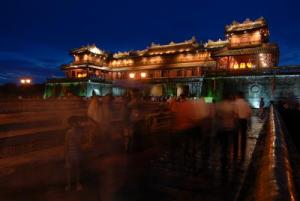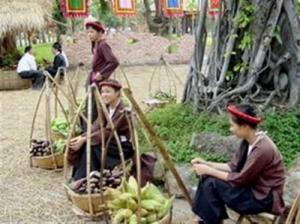Ao Dai (Áo Dài)
/photo_1033.jpg)
The most popular and widely-recognized national costume of Vietnam, the Ao Dai is a symbol to show the national pride. It leaves a lasting impression to anyone who comes and visit the place. Pronounced differently in varying parts of the country, ‘ow yai’ for most of the places in the South, and ‘ow zai’ in the North, it literally means “Long Dress”. With a contoured top flowing over loose-fitting trousers that reach the sole of the feet and brushing the floor, the dress style virtually drapes the whole body in soft flowing fabric. But having splits in the gown extending above the waist makes movement easy and comfortable. Though there are many variations in color and collar designs, the dress follows its typical two-piece garment design of top-fitting full-length tunic with high collar splitting into a front and back panel from the waist down. It looks very similar to the Chinese Qipao, which appears as a long gown worn over silk pants, and has slits on both sides as well.
Generally, the Vietnamese dress conservatively. The whole ensemble of Ao Dai exudes grace, modesty and beauty. Such symbolism have been rooted from Vietnam’s history and over time, the dress, along with what it represents have transcended all ages and Vietnamese from all walks of life continued to embrace it. Though the costume is intended both for men and women, the men wear it less, except for important occasion such as weddings and funerals. How the dress amazingly flatters any figure would easily make women feel comfortable and confident donning this beautiful piece of garment. The dress, mostly made from the finest silk or carefully chosen fabrics, is not only appealing to the eyes, but ensures comfort and freedom of movement.
The color of one’s Ao Dai is an indication of the age and status of the Vietnamese woman. Mostly, younger women wear white Ao Dais to symbolize their youthfulness and purity. They wear more pastel shades as they grow older but stay unmarried. Married women can don the rich, stronger shades. Certain colors are worn for worship and ritual ceremonies, e. g. blue, purple and brown. But the ones in more intricate patterns and designs are a popular choice of Vietnamese women for special occasions. And at weddings, national festivals and especially during Tet, this beautiful outfit is widely seen. Today, it has become a standard attire for office workers, hotel staff, receptionists and airline attendants, but a lot of women use it as an everyday outfit.
The tradition of clothing holds a long history dated back to 1744 when China’s imperial courts dictate what women should wear. The dress itself had several versions back then and it wasn’t only until 1930 when the dress appeared similarly to today’s Ao Dais. As every trend has its ups and downs, the Ao Dai itself almost went out of fashion during 1954 in the North and in 1975 in the South. But it regained its popularity over time - thanks to the likes of Prada, Giorgio Armani and other big names in the fashion industry. How they reinvented the Ao Dai and sported the beautiful dress into runways acquainted the whole world with the trend’s remarkable flair.
Designers constantly experiment with the fashion, fusing different materials and injecting newer looks into the design, but the totality of the Ao Dai remained an undying beauty and symbol of a strong and colorful culture. How it brings out the best of anyone who dons the garment, the Ao Dai is now widely recognized by women from all parts of the world. Modern fashion ideas are slowly incorporated into the trend, yet retaining its richness in Vietnamese culture. No matter how fashion designers try to recreate and breathe newer looks into the dress, comfort is never compromised as this, along with beauty, is the main attraction of the Ao Dai. Whatever change they try to incorporate to this trend, the dress remains conservative, and perhaps, wearing it more fitted is the sexiest a woman can go with it.
Reflecting the grace and elegance of Vietnamese women, it is an outfit that will always be fashionable and beautiful. No matter how many new trends will be introduced into Vietnam’s fashion mainstream, the Ao Dai remains a timeless classic no time, age, or season can dictate.









